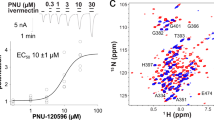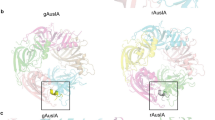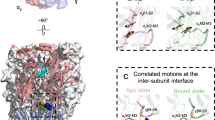Abstract
We determined the X-ray crystal structures of the extracellular domain (ECD) of the monomeric state of human neuronal α9 nicotinic acetylcholine receptor (nAChR) and of its complexes with the antagonists methyllycaconitine and α-bungarotoxin at resolutions of 1.8 Å, 1.7 Å and 2.7 Å, respectively. The structure of the monomeric α9 ECD superimposed well with the structures of homologous proteins in pentameric assemblies, denoting native folding, despite the absence of a complementary subunit and transmembrane domain. The interaction motifs of both antagonists were similar to those in the complexes with homologous pentameric proteins, thus highlighting the major contribution of the principal side of α9 ECD to their binding. The structures revealed a functionally important β7-β10 strand interaction in α9-containing nAChRs, involving their unique Thr147, a hydration pocket similar to that of mouse α1 ECD and a membrane-facing network coordinated by the invariant Arg210.
This is a preview of subscription content, access via your institution
Access options
Subscribe to this journal
Receive 12 print issues and online access
$189.00 per year
only $15.75 per issue
Buy this article
- Purchase on Springer Link
- Instant access to full article PDF
Prices may be subject to local taxes which are calculated during checkout



Similar content being viewed by others
References
Changeux, J.P. The nicotinic acetylcholine receptor: the founding father of the pentameric ligand-gated ion channel superfamily. J. Biol. Chem. 287, 40207–40215 (2012).
Unwin, N. Refined structure of the nicotinic acetylcholine receptor at 4A resolution. J. Mol. Biol. 346, 967–989 (2005).
Brejc, K. et al. Crystal structure of an ACh-binding protein reveals the ligand-binding domain of nicotinic receptors. Nature 411, 269–276 (2001).
Celie, P.H. et al. Nicotine and carbamylcholine binding to nicotinic acetylcholine receptors as studied in AChBP crystal structures. Neuron 41, 907–914 (2004).
Hansen, S.B. et al. Structures of Aplysia AChBP complexes with nicotinic agonists and antagonists reveal distinctive binding interfaces and conformations. EMBO J. 24, 3635–3646 (2005).
Dellisanti, C.D., Yao, Y., Stroud, J.C., Wang, Z.Z. & Chen, L. Crystal structure of the extracellular domain of nAChR α1 bound to α-bungarotoxin at 1.94 A resolution. Nat. Neurosci. 10, 953–962 (2007).
Bocquet, N. et al. X-ray structure of a pentameric ligand-gated ion channel in an apparently open conformation. Nature 457, 111–114 (2009).
Hilf, R.J. & Dutzler, R. X-ray structure of a prokaryotic pentameric ligand-gated ion channel. Nature 452, 375–379 (2008).
Li, S.X. et al. Ligand-binding domain of an α7-nicotinic receptor chimera and its complex with agonist. Nat. Neurosci. 14, 1253–1259 (2011).
Nemecz, A. & Taylor, P. Creating an α7 nicotinic acetylcholine recognition domain from the acetylcholine-binding protein: crystallographic and ligand selectivity analyses. J. Biol. Chem. 286, 42555–42565 (2011).
Huang, S. et al. Complex between α-bungarotoxin and an α7 nicotinic receptor ligand-binding domain chimaera. Biochem. J. 454, 303–310 (2013).
Hibbs, R.E. & Gouaux, E. Principles of activation and permeation in an anion-selective Cys-loop receptor. Nature 474, 54–60 (2011).
Althoff, T., Hibbs, R.E., Banerjee, S. & Gouaux, E. X-ray structures of GluCl in apo states reveal a gating mechanism of Cys-loop receptors. Nature 512, 333–337 (2014).
Miller, P.S. & Aricescu, A.R. Crystal structure of a human GABAA receptor. Nature 512, 270–275 (2014).
Hassaine, G. et al. X-ray structure of the mouse serotonin 5-HT3 receptor. Nature 512, 276–281 (2014).
Elgoyhen, A.B., Johnson, D.S., Boulter, J., Vetter, D.E. & Heinemann, S. α9: an acetylcholine receptor with novel pharmacological properties expressed in rat cochlear hair cells. Cell 79, 705–715 (1994).
Rothlin, C.V., Katz, E., Verbitsky, M. & Elgoyhen, A.B. The α9 nicotinic acetylcholine receptor shares pharmacological properties with type A γ-aminobutyric acid, glycine, and type 3 serotonin receptors. Mol. Pharmacol. 55, 248–254 (1999).
Lustig, L.R., Peng, H., Hiel, H., Yamamoto, T. & Fuchs, P.A. Molecular cloning and mapping of the human nicotinic acetylcholine receptor α10 (CHRNA10). Genomics 73, 272–283 (2001).
Elgoyhen, A.B. et al. α10: a determinant of nicotinic cholinergic receptor function in mammalian vestibular and cochlear mechanosensory hair cells. Proc. Natl. Acad. Sci. USA 98, 3501–3506 (2001).
Sgard, F. et al. A novel human nicotinic receptor subunit, α10, that confers functionality to the α9-subunit. Mol. Pharmacol. 61, 150–159 (2002).
Plazas, P.V., Katz, E., Gomez-Casati, M.E., Bouzat, C. & Elgoyhen, A.B. Stoichiometry of the α9α10 nicotinic cholinergic receptor. J. Neurosci. 25, 10905–10912 (2005).
Indurthi, D.C. et al. Presence of multiple binding sites on α9α10 nAChR receptors alludes to stoichiometric-dependent action of the α-conotoxin, Vc1.1. Biochem. Pharmacol. 89, 131–140 (2014).
McIntosh, J.M., Absalom, N., Chebib, M., Elgoyhen, A.B. & Vincler, M. α9 nicotinic acetylcholine receptors and the treatment of pain. Biochem. Pharmacol. 78, 693–702 (2009).
Elgoyhen, A.B., Katz, E. & Fuchs, P.A. The nicotinic receptor of cochlear hair cells: a possible pharmacotherapeutic target? Biochem. Pharmacol. 78, 712–719 (2009).
Psaridi-Linardaki, L., Mamalaki, A., Remoundos, M. & Tzartos, S.J. Expression of soluble ligand- and antibody-binding extracellular domain of human muscle acetylcholine receptor α subunit in yeast Pichia pastoris: role of glycosylation in α-bungarotoxin binding. J. Biol. Chem. 277, 26980–26986 (2002).
Zouridakis, M., Zisimopoulou, P., Eliopoulos, E., Poulas, K. & Tzartos, S.J. Design and expression of human α7 nicotinic acetylcholine receptor extracellular domain mutants with enhanced solubility and ligand-binding properties. Biochim. Biophys. Acta 1794, 355–366 (2009).
Stergiou, C., Zisimopoulou, P. & Tzartos, S.J. Expression of water-soluble, ligand-binding concatameric extracellular domains of the human neuronal nicotinic receptor α4 and β2 subunits in the yeast Pichia pastoris: glycosylation is not required for ligand binding. J. Biol. Chem. 286, 8884–8892 (2011).
Mukhtasimova, N., Free, C. & Sine, S.M. Initial coupling of binding to gating mediated by conserved residues in the muscle nicotinic receptor. J. Gen. Physiol. 126, 23–39 (2005).
Sine, S.M. & Engel, A.G. Recent advances in Cys-loop receptor structure and function. Nature 440, 448–455 (2006).
Verbitsky, M., Rothlin, C.V., Katz, E. & Elgoyhen, A.B. Mixed nicotinic-muscarinic properties of the α9 nicotinic cholinergic receptor. Neuropharmacology 39, 2515–2524 (2000).
Chen, L. In pursuit of the high-resolution structure of nicotinic acetylcholine receptors. J. Physiol. (Lond.) 588, 557–564 (2010).
Lee, W.Y. & Sine, S.M. Principal pathway coupling agonist binding to channel gating in nicotinic receptors. Nature 438, 243–247 (2005).
Mukhtasimova, N. & Sine, S.M. Nicotinic receptor transduction zone: invariant arginine couples to multiple electron-rich residues. Biophys. J. 104, 355–367 (2013).
Azam, L. & McIntosh, J.M. Molecular basis for the differential sensitivity of rat and human α9α10 nAChRs to α-conotoxin RgIA. J. Neurochem. 122, 1137–1144 (2012).
Yu, R., Kompella, S.N., Adams, D.J., Craik, D.J. & Kaas, Q. Determination of the α-conotoxin Vc1.1 binding site on the α9α10 nicotinic acetylcholine receptor. J. Med. Chem. 56, 3557–3567 (2013).
Karplus, P.A. & Diederichs, K. Linking crystallographic model and data quality. Science 336, 1030–1033 (2012).
Stothard, P. The sequence manipulation suite: JavaScript programs for analyzing and formatting protein and DNA sequences. Biotechniques 28, 1102, 1104 (2000).
Kabsch, W. Xds. Acta Crystallogr. D Biol. Crystallogr. 66, 125–132 (2010).
Evans, P. Scaling and assessment of data quality. Acta Crystallogr. D Biol. Crystallogr. 62, 72–82 (2006).
Collaborative Computational Project, Number 4. The CCP4 suite: programs for protein crystallography. Acta Crystallogr. D Biol. Crystallogr. 50, 760–763 (1994).
McCoy, A.J. et al. Phaser crystallographic software. J. Appl. Crystallogr. 40, 658–674 (2007).
Adams, P.D. et al. PHENIX: a comprehensive Python-based system for macromolecular structure solution. Acta Crystallogr. D Biol. Crystallogr. 66, 213–221 (2010).
Emsley, P. & Cowtan, K. Coot: model-building tools for molecular graphics. Acta Crystallogr. D Biol. Crystallogr. 60, 2126–2132 (2004).
Evans, P.R. & Murshudov, G.N. How good are my data and what is the resolution? Acta Crystallogr. D Biol. Crystallogr. 69, 1204–1214 (2013).
Filchakova, O. & McIntosh, J.M. Functional expression of human α9* nicotinic acetylcholine receptors in X. laevis oocytes is dependent on the α9 subunit 5′ UTR. PLoS ONE 8, e64655 (2013).
Acknowledgements
This work was supported by the European Commission Seventh Framework Programme grants 'NeuroCypres' (202088), 'REGPOT-NeuroSign' (264083) and 'BioStruct-X' (283570), and by the Greek General Secretariat for Research and Technology 'Aristeia grant' (1154), to S.J.T. We thank the staff at Swiss Light Source for their help during X-ray data collection, J.M. McIntosh (University of Utah) for providing the cDNAs of human α9 and α10 nAChRs, E. Eliopoulos and C. Poulopoulou for fruitful discussions and suggestions and J. Birtley and N. Kouvatsos for critical reading of the manuscript. This paper is dedicated to the late Nikos Oikonomakos, who was instrumental in the initiation of our structural efforts.
Author information
Authors and Affiliations
Contributions
S.J.T. and M.Z. conceived and designed the study. M.Z. and E.Z. performed construct design and protein expression and purification. E.Z. conducted the ligand-binding studies and mutagenesis. P.G. contributed to protein expression and purification and carried out crystallization, data collection and model refinement. D.C.-T., P.B. and M.Z. performed electrophysiology recordings and analysis. M.Z. and P.G. performed structure analysis and wrote the manuscript. All authors contributed with critical revisions of the manuscript. S.J.T. supervised the project with help from M.Z.
Corresponding author
Ethics declarations
Competing interests
The authors declare no competing financial interests.
Integrated supplementary information
Supplementary Figure 1 Sequence alignments of human α9 ECD.
(a,b) Alignments of α9 ECD with other human nAChR α ECDs (a) and with mouse α1 ECD (mA1), AChBPs (LsBP and AcBP for Lymnaea stagnalis and Aplysia californica AChBPs, respectively) and GLIC ECD (GLIC) (b). Numbering starts from the first amino acid residue of α9 ECD. The blue frame encloses Cys-loop residues. In a, the identical and similar residues are highlighted in red and grey, respectively. In b, identical residues are highlighted in red, residues participating in the hydration pocket are in cyan, glycosylated Asn residues are in yellow and residues participating in the membrane-facing interaction network are in orange. Secondary structure assignment is also shown for α9 ECD.
Supplementary Figure 2 Gel-filtration analysis of human α9 ECDs.
(a) Superposition of the size exclusion chromatograms of α9 ECD (solid line) and its deglycosylated form (dashed line) after treatment with EndoHf. α9 ECD was expressed mainly as a monomer (2nd peak) and secondarily as a dimer (1st peak) and high molecular mass aggregates (shoulder of 1st peak). SDS-PAGE analysis showed molecular masses of ~32 kDa and ~26 kDa for the glycosylated and deglycosylated monomeric α9 ECDs, respectively (inset), and revealed high purity [Lane1: α9-ECD; Lane 2: molecular mass standards; Lane 3: deglycosylated α9 ECD (+EndoHf)]. Arrows indicate the peaks of eluted protein markers of known molecular mass. (b) Superposition of the size exclusion chromatograms of the monomeric states of α9 ECD (solid line) and its deglycosylated form (dashed line) isolated from a. As shown, the monomeric state of α9 ECD is maintained; however in the deglycosylated α9 ECD, a small proportion of the protein forms dimers after treatment with EndoHf. The inset shows Western-blot analysis of the monomeric fractions of the proteins, using anti-His antibody [Lane1: molecular mass standards; Lane 2: α9 ECD; Lane 3: deglycosylated α9 ECD (+EndoHf)]. In both panels, y axis shows the protein absorbance at 280 nm (A280).
Supplementary Figure 3 Pharmacological characterization of human α9 nAChR ECD.
(a) Specific binding of 125I-α-Bgtx to glycosylated and deglycosylated α9 ECD. Equilibrium saturation radioligand binding was performed on purified monomeric α9 ECDs. Notably, the oligomeric states of α9 ECD (Supplementary Fig. 2a) did not bind 125I-α-Bgtx (data not shown). Data presented for specific binding (black squares) and nonspecific binding (open squares) are from a single experiment performed in triplicate but are typical of 3-4 independent determinations, giving the presented mean Kd and Bmax values. (b) Equilibrium 125I-α-Bgtx binding was performed with a variety of competing ligands to the monomeric state of deglycosylated α9 ECD. Data points are means of triplicate samples. Each graph is from a single experiment but is typical of 3-4 individual experiments. Mean Ki values are presented in Supplementary Table 1. Values in x axis correspond to molar concentration of non-labeled ligands in log scale.
Supplementary Figure 4 Comparison of the apo–α9 ECD with homologous proteins and antagonist-bound α9 ECDs, and observed crystal-packing interactions.
(a) Superposition of the β-sandwich core of α9 ECD with the corresponding regions of homologous structures. The r.m.s. deviations between Cα atoms are 0.811 Å with mouse α1 ECD, 1.011 Å with Aplysia californica AChBP, 2.931 Å with Torpedo nAChR α ECD and 2.578 Å with GLIC ECD. (b) Superposition of the apo (green), MLA-bound (cyan) and α-Bgtx-bound (magenta) α9 ECD structures. The MLA-bound and α-Bgtx-bound structures superimposed very well with the apo structure, with their Cα atoms deviating by 0.475 Å and 1.534 Å, respectively from those of the apo structure. The regions that differ mostly between the apo and the MLA-bound structures are Cys loop and loop F, while between the apo and the α-Bgtx-bound structures the main differences occur mainly in loop C and secondarily in Cys loop and loop F. Most of these differences are attributed to the crystal packing interactions involving loop C and Cys-loop in the apo and MLA-bound structures. (c) The two α9 ECD molecules (in green and magenta) of the asymmetric unit of the MLA-bound α9 ECD crystals interact through a hydrogen bond between residues of loop C (of green-colored molecule) and loop F (of magenta-colored molecule). The bound MLA is shown in surface representation. (d) The same interaction occurs in the apo–α9 ECD crystals between symmetry-related molecules (in green and magenta). (e) Close-up view of the superposition of the apo (in green) with the MLA-bound (in cyan) α9 ECD. MLA is shown in surface representation. (f) Close-up view of the superposition of the apo (in green) with the α-Bgtx-bound (in cyan) α9 ECD. α-Bgtx is shown in magenta.
Supplementary Figure 5 Superpositions of the antagonist-bound α9 ECD complexes and of α9 ECD networks with the corresponding homologous proteins, and view of the α9 ECD(–) side.
(a) Side-view of superimposed MLA complexes of homologous proteins. α9 ECD in green, mutants II (carries the AChBP loop C) and III (carries the α7 loop C) of α7 ECD–AChBP chimeras10 in cyan and magenta, respectively, and AChBP5 in yellow. The MLA molecules (in stick representation) are in the same color with the proteins bound to. (b) Side-view of the α-Bgtx complexes with α9 ECD (in green), α1 ECD6 (in grey) and α7–AChBP11 (in magenta), after superposition of the ECDs. The α-Bgtx molecules are shown in ribbon representation and are in the same color with the proteins complexed with. (c) Superposition of the hydration pockets of human α9 ECD (in green) and mouse α1 ECD (in cyan). Interactions between hydration pocket elements are in green and blue for α9 ECD and α1 ECD, respectively. The participating water molecules are shown as red spheres. (d,e) Superposition of the membrane-facing network of apo–α9 ECD (in green) with the corresponding networks in GLIC7 (in magenta) (d) and human GABAAR14 (in cyan) (e), as viewed from the bottom. Similar results were obtained when superimposing the networks in α9-ECD and mouse 5-HT3 receptor. The interactions in α9-ECD are in green and the interactions in GLIC and GABAAR are in blue. (f) Side-view of the α9 ECD(-) side. Residues Gln36 (unique in α9 and α10), Ile61, Arg81 and Thr119 are involved in α-Ctx Vc1.1 binding35. Asp121 (unique in α9 and α10), which is critical for conferring selectivity to α-Ctx RgIA46, formed a salt bridge with the also unique Arg59.
Supplementary information
Supplementary Text and Figures
Supplementary Figures 1–5 and Supplementary Table 1 (PDF 2072 kb)
Rights and permissions
About this article
Cite this article
Zouridakis, M., Giastas, P., Zarkadas, E. et al. Crystal structures of free and antagonist-bound states of human α9 nicotinic receptor extracellular domain. Nat Struct Mol Biol 21, 976–980 (2014). https://doi.org/10.1038/nsmb.2900
Received:
Accepted:
Published:
Issue Date:
DOI: https://doi.org/10.1038/nsmb.2900
This article is cited by
-
Complex approach for analysis of snake venom α-neurotoxins binding to HAP, the high-affinity peptide
Scientific Reports (2020)
-
High-Affinity α-Conotoxin PnIA Analogs Designed on the Basis of the Protein Surface Topography Method
Scientific Reports (2016)
-
Computational determination of the binding mode of α-conotoxin to nicotinic acetylcholine receptor
Journal of Ocean University of China (2016)
-
Conotoxin αD-GeXXA utilizes a novel strategy to antagonize nicotinic acetylcholine receptors
Scientific Reports (2015)
-
Less is More: Design of a Highly Stable Disulfide-Deleted Mutant of Analgesic Cyclic α-Conotoxin Vc1.1
Scientific Reports (2015)



